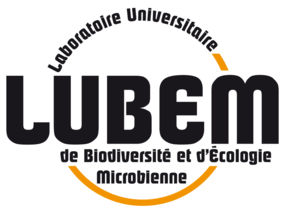Lead:
Specific Objectives :
Screening of HNS biodegradation activities and mycosurfactant production from 500 fungal strains from the UBOCC and LUBEM collection with the final aim of 2 positive hits by HNS.
Discovery of new mycosurfactants and/or biodegradation activities specific to 4 emblematic HNS (TRL3).
Screening of HNS biodegradation activities and biosurfactant production from 500 fungal strains
A selection of 500 fungal isolates will be first processed using a targeted approach in order to select specific taxa which have already shown abilities to degrade complex pollutants and/or to produce biosurfactants but also depending on their isolation site for a specific focus on contaminated habitats. This strategy is directed towards enhancing the probability to detect effective degraders and appears more efficient than a stochastic approach based on serendipity.
HNS biodegradation will be first assessed using a high-throughput ecophysiological screening approach based on Laser Nephelometry. To identify isolates with potential to degrade HNS, they will be grown in different HNS-containing media either as a unique carbon source or in combination with another carbon source as well as under different C:N ratios. Fungi will be grown in different culture media previously shown to support mycosurfactant production in the Duetz-MTPS system (Enzyscreen, Netherlands) allowing cultivation of fungi at a high-throughput rate. Following cultivation, culture supernatants will be subjected to rapid methods for assessing mycosurfactant production (i.e. Drop Collapse Test and Oil Spreading Test).
Aim of this task is to highlight 16 most promising fungal isolates which will be then deeply analyzed for mycosurfactant production (8 isolates) and for HNS biodegradation (8 isolates, 2 per HNS).
Optimization of strain culture conditions - Screening for surfactant activities by state-of-the-art tests - First step of chemical purification and analysis of culture supernatants
The optimization of culture conditions of selected strains will be carried out by an experimental design and using the Duetz-MTPS system. In order to assess the effect of the different tested conditions on surfactant production, rapid quantitative tests, DCT and OST tests, will be performed allowing selection of optimized medium composition yielding to the highest surfactant activities.
Next step will consist in applying the optimized conditions for each selected fungal strain at a larger scale (i.e., in 100-mL flask culture). Measurement of surfactant activity will be carried out on obtained supernatants, including DCT, OST tests, emulsification index (E24) and surface tension measurements. The isolation of biosurfactants will be performed by solvent extraction and optimized in terms of clean-up efficiency and recovery. The purified extract will be analyzed either by Thin Layer Chromatography (TLC) or by MALDI-TOF.
For hydrophobin identification, non-ionic surfactant aqueous solution such as Berol 532, will be added to the culture supernatant. After mixing and settling, the hydrophobins-enriched surfactant phase will be collected and mixed with an alcoholic solvent (ethanol or isobutanol) in order to extract the protein back to the aqueous phase. A SDS-PAGE of the hydrophobin aqueous solution will enable us to assess the purity of the protein fraction.
Optimization – Ecotoxiciti and first step to chemical analysis
Optimization of strain culture conditions - First scale-ups using 24-well-plate culture
Aim of this task is to delve deeper on the most promising fungal isolates. For the 8 targeted fungal isolates, numerous culture conditions will be used to search for improved HNS degradation potential using Laser Nephelometry and 96- to 384-well microplates.
Normalized ecotoxicity tests against model organisms
Normalized ecotoxicity tests against model organisms will be run. Assays will be run using model species representing various trophic levels and for which standardized methodologies have been developed and proven to be relevant, reliable, repeatable, reproducible and robust.
Culture conditions: optimization of enzymatic activities against HNS
This task is an extension step to the screening approach to identify among 8 fungi preselected in WP1, their ability to metabolize HNS (reduction of HNS). The interest in using filamentous fungi in bioremediation stems from their ability to produce several extracellular enzymes which are capable of degrading several types of chemical bonds and eliminating a wide range of pollutants.
Our aim is to enhance extracellular enzymes production and optimize the degradation ability of these enzymes by using different physiochemical parameters (culture conditions) and better understanding the mechanism involved in the metabolism of interest.
Chemical analysis of extracellular content - Chemical analysis of metabolites
The first step for the NMR monitoring of the degradation process will be obtaining the 1H and 13C fingerprints of all pollutants. Analyses will also be performed on glyphosate and AMPA.
The effectiveness of the degradation of HNS by fungi will be mainly checked by 1H NMR experiments.
The NMR monitoring of the production of mycosurfactants will be achieved by 1H NMR experiments using the protocol previously described. If necessary, the identification of the mycosurfactant type will be confirmed by 13C and 2D NMR experiments.
RELATED DELIVERABLES
D1.1.1: A list of 500 fungal isolates with potential interest
D1.1.2: Growth parameters of 500 fungal isolates cultured under numerous conditions and selection of the most promising isolates in terms of ability to utilize HNS as carbon, nitrogen or phosphorus source
D1.1.3: Identify fungal isolates with promising surfactant activities
D1.2.1: A detailed and optimized protocol to obtain the surfactant fraction from the 8 most promising fungal isolates selected in task 1.1
D1.2.2: Purification and analysis methods efficient for biosurfactant identification in culture supernatants
D1.3.1: List of fungal strains with biosurfactant and HNS degradation activities
D1.3.2: Enzymatic profile of the most promising fungal strains
D1.3.3: A list of strains meeting able of growing on contaminated media and biodegrading the pollutant studied without emitting toxic concentrations of degradation products into the environment will be established. Strains not meeting these criteria will be excluded from the study

